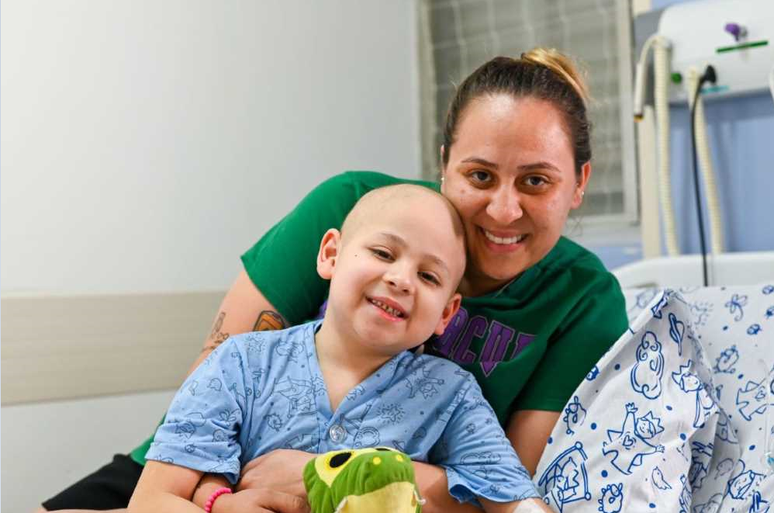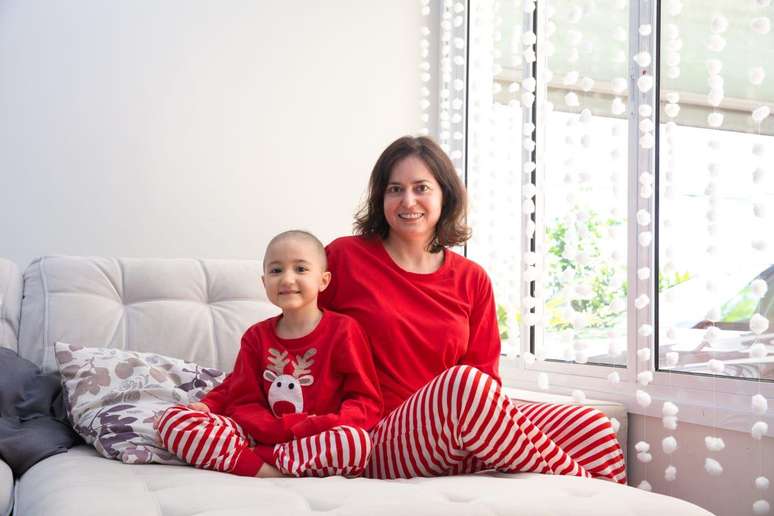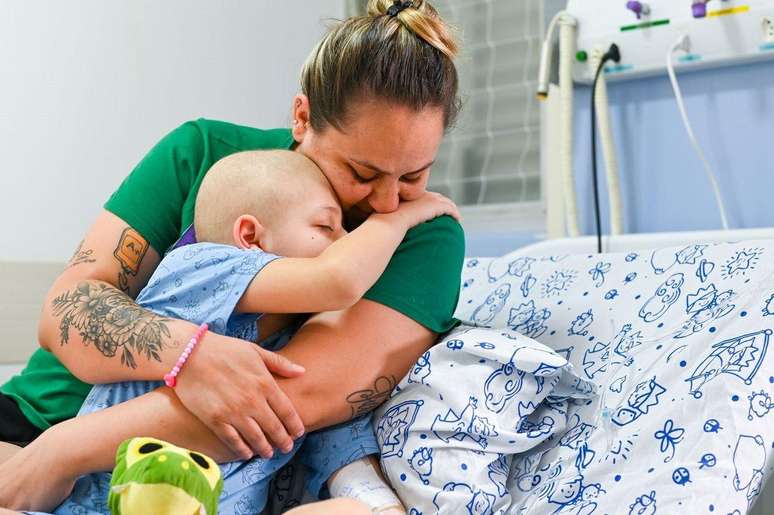The National Cancer Institute estimates that by 2025 there will be more than 11,000 cases of leukemia in the country.
Early last year, Miguel de Mello Bueno, just 7 years old, complained of pain in his leg after an intense day of playing on the beach.
Finding the situation strange, mother Halana Karine de Mello, 29, took her son to the emergency room, where he was treated and released.
A few weeks later, a new complaint. Looking for a pediatrician in Ponta Grossa (PR), the city where they live, Halana calmed down and informed her that her pain was due to the child’s growth phase.
“The pain was infrequent. It occurred every 15 or 20 days, lasted a day and went away. The blood tests were normal, so I thought it was due to growth,” recalls the mother.
However, in May, an episode of intense pain, which left Miguel unable to walk, prompted the family to seek hospital treatment. The boy, in addition to pain in his legs, also had pain in his back and was pale.

“He was crying in pain. The doctors decided to hospitalize him to undergo several tests. In the first blood test, changes in his platelets had already been found,” recalls Halana.
Miguel was diagnosed with acute lymphocytic leukemia. This type of blood cancer affects white blood cells, which are our body’s defense cells.
A survey by the National Cancer Institute (Inca) estimates that in the three-year period 2023-2025, 11,540 cases of leukemia will be recorded in the country.
Cancer in children and adolescents is rare and represents only 3% of the total new cases expected each year in Brazil. However, leukemia is what affects this population the most, accounting for 25% to 35% of all childhood cancers.
“In this population, due to the growth phase, the cells reproduce very rapidly and during this reproduction a cellular mutation can occur in the bone marrow,” explains Ana Paula Kuczynski, pediatric oncologist at the Pequeno Príncipe Hospital.
There are more than 12 types of leukemia, the most common being acute myeloid leukemia (AML) and acute lymphocytic leukemia (ALL).
The chances of recovery are different for children and adults. Acute lymphoid leukemias are the most common in children and adolescents and have a cure rate of between 85% and 90%.
For children with myeloid, the chances are between 60% and 65%, as this type is considered more aggressive for this group.
Another relevant fact is that leukemia represents the leading cause of death due to diseases among children and adolescents aged between one and 19 years in the country, approximately 8% of the total.
“Just as the cells in children’s bodies reproduce faster, this also happens with diseased cells, which reproduce even faster than in adults, causing a rapid spread of the disease”, explains Viviane Sonaglio, pediatrician in charge of the Reference Center for the pediatric tumors of the ACCamargo Cancer Center hospital.
Regarding risk factors, cancer in childhood is not related to external factors such as environmental, dietary or lifestyle conditions, as is the case in adults.
However, some children have a genetic predisposition to the disease, such as those with Down syndrome, who are up to 25 times more likely to be affected by leukemia, according to experts interviewed by BBC News Brasil.
“This syndrome is known as trisomy 21, which is a genetic change that occurs during cell division in the fetus. The fact that a baby has already had this cellular change increases the chances of a new cellular change occurring, increasing the chances of disease,” adds Kuczynski.
Pay attention to all signs

Leukemia is a disease that affects the bone marrow, where blood is produced, so the most common symptoms are paleness, anemia, weakness and tiredness. As a result, bumps on the neck, armpits, and belly are common. In addition to the purple spots on the body.
However, this is not always the case. Luísa Alves Spíndola, 9, was diagnosed with acute lymphoblastic leukemia in 2019. According to the girl’s mother, Vanessa Alves Spindola, the first sign that something was wrong with her daughter was her lack of appetite.
“She began to lose her appetite and sweat a lot at night. We thought this was strange and took her to the pediatrician, who asked for a blood test. The tests showed a small change and the pediatrician even thought it might be a laboratory error. We repeated the test a week later and the change was already much greater. At that point we started investigating the cause,” explains the mother.
A few days after the diagnosis, the child was referred for chemotherapy treatment. The results were positive in the first month and the disease began to regress.
In 2021, Luísa finished her chemotherapy sessions and currently only undergoes routine check-ups every six months.
“He leads a normal life, attends school and plays sports. We attribute his rapid recovery to the early diagnosis, which prevented the cancer from taking on larger proportions and regressing after the first chemotherapy sessions,” adds Vanessa.

For an early diagnosis, parents and pediatricians need to pay attention to any different signs in the child’s behavior. And don’t belittle the complaints of the little ones.
«A child who has an unjustified fever or who begins to wake up at night with pain, for example, should be investigated as to the cause. When the signs become more evident, such as pallor or bleeding, it is because the disease is progressing” , explains pediatric oncologist Melissa Ferreira de Macedo, member of the Brazilian Association of Lymphomas and Leukemias (Abrale).
For the diagnosis, a blood count is initially required where the reduction in platelets and changes in white blood cells can be analyzed. In most cases, during the examination it is also possible to see leukemia cells in the patient’s blood.
If changes are detected, you should order other tests before making a diagnosis. One of these tests is the myelogram, which analyzes the bone marrow.
According to Inca the main symptoms of leukemia are:
- Fever for more than seven days without apparent cause
- Bone pain
- Appearance of purple spots on the skin
- Pallor
- Persistent and progressive headache, especially at night, which wakes the child or appears when he gets up in the morning, accompanied by vomiting or neurological signs.
- Leukocoria (white reflex in the pupil of the eye when exposed to light)
- Visual disturbances
Source: Terra
Ben Stock is a lifestyle journalist and author at Gossipify. He writes about topics such as health, wellness, travel, food and home decor. He provides practical advice and inspiration to improve well-being, keeps readers up to date with latest lifestyle news and trends, known for his engaging writing style, in-depth analysis and unique perspectives.







![Such a wonderful sun in advance: Summary of the episode on August 28, 2025 [SPOILERS] Such a wonderful sun in advance: Summary of the episode on August 28, 2025 [SPOILERS]](https://fr.web.img2.acsta.net/img/9b/10/9b10f4f0224ab0aea303ed7fbf38edd1.jpg)
